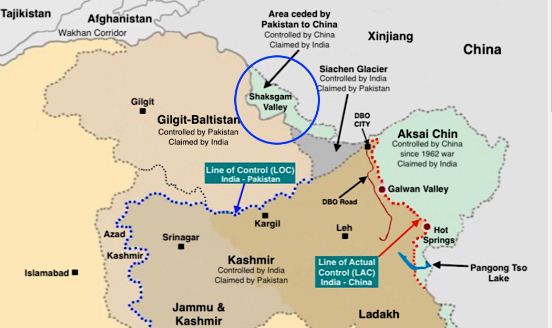May 9, 2024
What is Shaksgam Valley Disputes? India & China: History of Shaksgam Valley Dispute
Why in News ?India has recently lodged a strong protest with China for carrying out construction activities in the Shaksgam valley, in an “illegal” attempt to alter the situation on the ground.
The Shaksgam Valley dispute is a territorial disagreement between India and China.
Location: The Shaksgam Valley is a high-altitude valley located in the northern part of Pakistan-occupied Kashmir (PoK). It borders Xinjiang Province of China to the north and the Siachen Glacier region to the east.
The Dispute:
India’s Claim: India considers Shaksgam Valley a part of its territory, included within the Ladakh region of Jammu and Kashmir.
China’s Claim: China claims the Shaksgam Valley based on a boundary agreement signed with Pakistan in 1963.
India’s Rejection: India rejects the legitimacy of the 1963 agreement as it was signed by Pakistan without India’s consent.
Reasons for Significance:
Strategic Location: The Shaksgam Valley holds strategic importance due to its proximity to the Siachen Glacier, a militarised zone. It also provides access to the Xinjiang province of China.
Border Tensions: The dispute contributes to the overall India-China border tensions.
Current Status:
No Resolution: The dispute remains unresolved.
Indian Protests: India continues to register protests with China regarding any infrastructure development activities in the Shaksgam Valley.

History of disputes:
The history of the Shaksgam Valley dispute involves India, Pakistan, and China.
Pre-Independence:
- The Shaksgam Valley was historically administered by the Maharaja of Kashmir, a princely state in British India.
- The boundary with China in this region was not precisely defined.
Post-Independence (1947):
- After India’s independence, Pakistan gained control of the Shaksgam Valley along with the rest of Gilgit-Baltistan. India claims the entire region of Kashmir, including Shaksgam.
1962 Sino-Indian War:
- The Sino-Indian War of 1962 strained relations between China and India.
1963 China-Pakistan Agreement:
- In 1963, China and Pakistan signed a boundary agreement. This agreement ceded the Shaksgam Valley to China.
- India strongly criticized this agreement, as it involved Pakistan conceding territory that India claimed.
- Article 6 of the Agreement included a clause stating that after the settlement of the Kashmir dispute between Pakistan and India, the relevant party (presumably India) could reopen negotiations with China regarding the border.
Current Status:
- The Shaksgam Valley remains under Chinese control.
- India continues to claim the valley as part of its territory.
- The 1963 Agreement and Article 6’s provision for renegotiation are points of contention.
Significance of the Dispute:
- The Shaksgam Valley dispute is a part of the larger Kashmir conflict between India and Pakistan.
- The valley has strategic importance due to its proximity to the Karakoram Highway, a vital link between China and Pakistan.
- The dispute also holds symbolic significance for India’s territorial integrity.
Other Key facts:
- The exact area of the Shaksgam Valley is disputed, with estimates ranging from 3,750 to 5,180 square kilometers.
- Diskussion around the legality of the 1963 Agreement from India’s perspective persists since Pakistan was not the rightful owner of the territory according to them.
What are major disputed regions of India with other countries
India has territorial disputes with several neighboring countries.:
China:
- Aksai Chin: This vast desert plateau lies in the Ladakh region of Jammu and Kashmir. China claims Aksai Chin as part of Xinjiang province, while India considers it a part of its territory.
- Western Sector (Ladakh): This includes areas along the Line of Actual Control (LAC), a loosely defined border between India and China. Territorial disagreements and occasional standoffs occur here.
- Eastern Sector (Arunachal Pradesh): China claims the entire state of Arunachal Pradesh, which India administers.
Pakistan:
- Jammu and Kashmir: This is a complex dispute with a long history. Pakistan controls a portion of Kashmir (including Gilgit-Baltistan) while India claims the entire region.
- Siachen Glacier: The world’s highest battlefield, Siachen Glacier, is located in the eastern Karakoram range. Both India and Pakistan claim control over the glacier.
Nepal:
- Kalapani-Limpiyadhura: This is a small disputed territory on the India-Nepal border. Both countries have differing interpretations of historical treaties regarding ownership.
Bangladesh:
- Land Enclaves: This involved a complex web of enclaves where tiny Indian territories existed within Bangladesh and vice versa. Most have been swapped in recent decades to simplify borders. There might still be a few minor unresolved pockets.
Bhutan:
- Doklam: A 2017 standoff occurred at the tri-junction border between India, China, and Bhutan. The dispute centered on Doklam, a claimed area by Bhutan and China.
January 30, 2025
January 20, 2025
January 14, 2025
